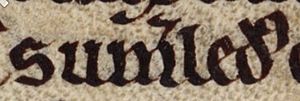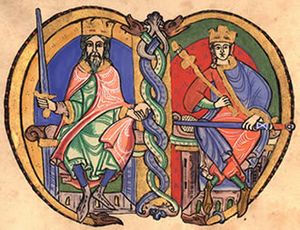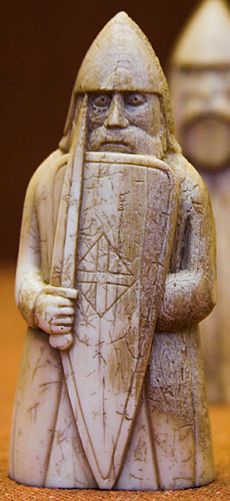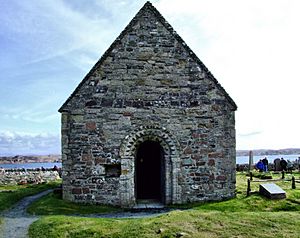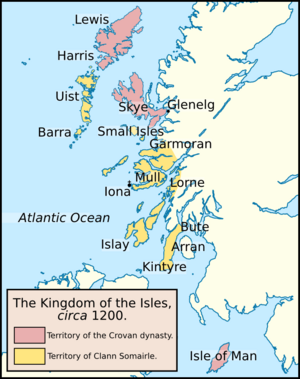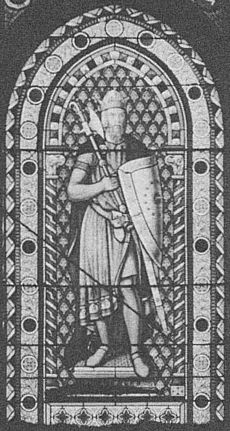Somerled facts for kids
Quick facts for kids Somerled |
|
|---|---|

Somerled's name as it appears on an old book called the Chronicles of Mann: "Sumeledo".
|
|
| King of the Isles | |
| Reign | c. 1158–1164 |
| Died | 1164 Battle of Renfrew |
| Burial | probably Iona |
| Consort | Princess Ragnhildis Olafsdottir of Man |
| Issue | GilleBride, Dubgall, Ragnall, Aonghas, Olaf, Bethóc |
| Father | GilleBride |
Somerled (died 1164) was a powerful leader in the mid-1100s. He was known as a Norse-Gaelic lord. This means he had both Norse (Viking) and Gaelic (Scottish/Irish) roots. Through smart marriages and winning battles, Somerled grew his power. He eventually created his own kingdom in Argyll and the Scottish Isles.
Not much is known for sure about Somerled's early life. He might have been born in northern Ireland. His family was important, with Irish royal ancestors. Somerled married Ragnhild, the daughter of Óláfr Guðrøðarson, who was the King of Man and the Isles. This marriage happened around 1140.
In 1153, King Óláfr died. His son, Godred, became king. But Godred was not popular with his people. A leader from Man asked Somerled to let his son, Dugall, become king instead. Somerled agreed. In 1156, Somerled sailed with 80 ships to fight Godred. After a sea battle, they split the kingdom. But Godred still didn't accept Dugall as king. So, two years later, Somerled defeated Godred and took over the whole kingdom. He ruled Argyll, Man, and the Isles until he died.
Somerled was killed in 1164 during a fight in mainland Scotland called the Battle of Renfrew. He was leading his army from across his kingdom. We don't know exactly why he attacked Scotland. Maybe he wanted to stop Scottish power from growing. But his large army suggests he had bigger plans. After his death, Somerled's big kingdom broke apart. However, his sons kept control of much of the southern Scottish islands.
Somerled is often seen as a Celtic hero. People say he defeated the Vikings and brought back Gaelic culture. But old records show he was part of the same Norse-Gaelic culture as his neighbors. He was a very important person in the history of Scotland, the Gaels, and the Isle of Man. Many Scottish clans proudly say they are related to Somerled. Recent studies suggest he has hundreds of thousands of descendants today.
Contents
Somerled's Family Roots
Somerled's family history is a bit of a mystery. We don't have a clear family tree from his time. But many later writings try to show his family line. These writings agree on his father, GilleBride, and his grandfather, GilleAdamnan. These names also appear in old Irish records. However, the names before that are less certain.
Somerled was almost certainly from a Norse-Gaelic family. We don't know much about his childhood. Some old stories say his family was important in Argyll. They were supposedly forced out by Vikings and Scots. Even if these stories aren't fully true, Somerled's marriage to a king's daughter shows his family was very important. Also, one of his relatives married the son of a Scottish king.
Somerled and the Scottish Royal Family
Somerled's family had connections to the Scottish royal family. This connection helped him gain power. The Chronicle of Holyrood, an old book, says that the sons of Malcolm were Somerled's "nepotes." This Latin word can mean nephews or grandsons. This suggests that Malcolm's mother was either Somerled's sister or daughter. Or, Somerled and Malcolm could have been half-brothers. These family ties meant Somerled had a stake in who would be the next Scottish king.
In 1153, King David I of Scotland died. His grandson, Malcolm IV, became king at only 12 years old. Just a few months later, Somerled started a rebellion. He joined with his "nepotes" against the new young king. An old poem says Somerled attacked and damaged Glasgow and its cathedral. Malcolm, the father of Somerled's "nepotes," was the son of an earlier Scottish king, Alexander I. This made Malcolm's family a strong rival for the throne. Somerled's involvement in this rebellion shows he was deeply involved in Scottish politics.
King David I had fought with Malcolm for control of Scotland before. Malcolm was captured in 1134. The fact that Malcolm's sons rebelled with Somerled suggests Somerled's family might have been allies with Malcolm even earlier. King David I also tried to control Argyll. He collected taxes and tribute from the area. This shows he saw Argyll as part of his kingdom. But Somerled clearly saw himself as an independent ruler.
Around 1140, Somerled married Ragnhild, the daughter of the King of the Isles. This was part of a series of marriages between powerful families in Argyll, Galloway, and the Isles. These marriages might have been a way for Scotland to gain more influence in the region. In 1153, King Óláfr of the Isles was killed. His son, Godred, became king. But these events made the whole region unstable.
Taking Over the Isles
In 1154, a war started in Ireland. This war weakened Godred's power in the Isles. Around 1156, Somerled took advantage of the situation. An important leader from the Isles, Thorfinn Ottarsson, asked Somerled to put his son, Dugald, on the throne instead of Godred. Dugald was King Óláfr's grandson, and Somerled was a strong leader. Many people in the Isles were unhappy with Godred. Somerled saw this as a chance to get his eldest son a share of the kingdom.
Not everyone supported Somerled's plan. But after a big sea battle, Somerled and Godred decided to split the kingdom. Somerled took control of the southern Isles, and Godred kept the northern parts. Some stories say Somerled had helped Godred's father in earlier battles. This might have given Somerled a claim to some of the lands he took.
After the kingdom was divided, Somerled and Godred had a truce. But about two years later, in 1158, Somerled attacked Godred again. This time, he drove Godred out of the kingdom completely. From then until his death, Somerled ruled the entire Kingdom of the Isles. He might have also had some influence in Galloway. Around 1160, Somerled made peace with the Scottish king, Malcolm IV. This agreement might have happened after Somerled helped the Scots against another leader, Fergus.
Somerled's Rule and Religion
Somerled and Ragnhild had four sons: Dugald, Ranald, Angus, and Olaf. They also had a daughter, Bethoc. Somerled's family claimed the right to rule the Isles because Ragnhild was from the Crovan dynasty. This was a powerful Norse-Gaelic family. Somerled was likely called "King of the Isles." This title was later used by his descendants, who became known as the "Lords of the Isles."
From about 1160 to 1164, Somerled's activities are not well recorded. In 1164, he tried to convince Flaithbertach Ua Brolcháin, the Abbot of Derry, to move to Iona. Iona was a very important religious island in Somerled's territory. Flaithbertach was the head of the Columban monastic community, a group of religious houses. If he moved to Iona, it would have put the community's leadership right in Somerled's kingdom. This plan suggests Somerled had big ambitions, even beyond the Isles, into northern Ireland. But he died later that year, and his plan failed.
Somerled seemed to prefer older religious traditions. His attempt to bring the Columban leaders back to Iona was different from his sons' actions. His sons later destroyed the Columban monastery on Iona and built a new Benedictine monastery.
Somerled or his son Ranald might have founded Saddell Abbey. This was a small Cistercian monastery in Kintyre. Some evidence suggests Ranald was the founder. However, an old French list from 1160 mentions a Cistercian house called "Sconedale," which might refer to Saddell. It's possible Somerled started planning the monastery, and Ranald finished it. But Somerled's desire to move the Columban leaders to Iona suggests he might not have liked the newer Cistercian order. While some stories say Somerled was buried at Saddell Abbey, it's more likely he was buried on Iona. St Oran's Chapel on Iona is the oldest building there. Its style suggests it was built around the mid-1100s, possibly by Somerled or Ranald.
Somerled's Death
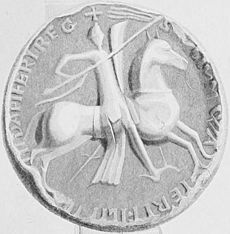
In 1164, Somerled died during a sea invasion of Scotland. This attack ended in the terrible Battle of Renfrew. He fought against forces led by the Bishop of Glasgow and the Sheriff of Lanark. The invasion seemed well-planned. Old records say Somerled's army was huge, with one source claiming 160 ships. But medieval writers often exaggerated numbers. Both records say his forces landed at Renfrew. They fought the Scots and suffered many losses, even though the Scottish force was much smaller. Some sources say one of Somerled's sons, GilleBride, also died in the battle.
It's not clear why Somerled attacked Scotland. In the early 1160s, Scottish power was growing in the areas near Somerled's kingdom. The Scots were settling new lands and building influence. Somerled's invasion might have been a response to this. He might have wanted to stop Scottish power from spreading into his territory. Renfrew was an important center for Walter FitzAlan, the Steward of Scotland. Somerled's forces might have fought Walter's army. Walter and Somerled likely had competing goals in the region.
Somerled might have wanted to remove this threat. But the huge size of his invasion suggests he had even bigger plans. The Scottish king was sick at the time. Somerled might have seen this as a perfect chance to gain more power.
What Happened After Somerled's Death
After Somerled died, his large sea-kingdom broke into pieces. Many people tried to take control. Somerled's son, Dugald, might have been king for a short time. But soon, Godred, Somerled's brother-in-law, returned from exile. With help from Norway, Godred defeated his own brother and took the throne of Man. Godred eventually got back most of the northern Scottish islands.
However, the islands Somerled had taken from Godred in 1156 stayed with Somerled's sons. It's likely these lands were divided among his surviving sons. The exact division is not known. But Somerled's sons' lands probably stretched from Glenelg in the north to Kintyre in the south. Angus might have ruled the north, Dugald the central area, and Ranald the south.
The Scots might have been happy about Somerled's death. But it led to many years of trouble in the region. Norway's help for Godred showed that Scotland wasn't the only country interested in the area. Walter FitzAlan and his son, Alan, continued to expand their family's power westward. Somerled's descendants also fought among themselves. Ranald allied with Alan to gain an advantage over his brother Angus. Through this alliance, the Stewards gained control of the Isle of Bute around 1200.
Somerled's Children
Somerled had at least five sons and one daughter. GilleBride died in battle with his father. Olaf is only mentioned in one old book. Angus defeated his brother Ranald in 1192, and Ranald is not mentioned again for a while. Angus later died in 1210, along with his sons. Dugald was last mentioned in 1175. Bethoc, Somerled's daughter, was the prioress (leader) of the Iona Nunnery. Both Dugald and Ranald had powerful children who continued their family lines.
From Dugald came the Lords of Argyll and Clan MacDougall. From Ranald came the Lords of the Isles, Clan Donald, Clan MacRory, and Clan MacAlister.
Since the early 2000s, scientists have studied the DNA of men with Scottish last names linked to Somerled. A study in 2004 found that five chiefs of Clan Donald, who all said they were related to Somerled, did share a common ancestor. More tests on men named MacAlister, MacDonald, and MacDougall showed that many of them shared this same genetic marker. This suggests Somerled might have almost 500,000 living male descendants today. Another study in 2011 found that 23% of MacDonald men tested had this marker. This marker is rare in Celtic areas but common in Norway. Both studies concluded that Somerled's male ancestors came from Scandinavia.
Somerled's Place in History
Over time, people have thought about Somerled in different ways. Old stories and clan histories often show Somerled as a Celtic hero. They say he freed Scotland from Viking invaders, created his own kingdom, and brought back Gaelic culture. But these ideas come from later writings and don't always match what old records say. Modern historians see Somerled as part of the same Norse-Gaelic culture as his rivals.
For a long time, historians thought Somerled's fights with the Scots were about native Celtic people resisting new feudal customs. But more recent studies show that people in northern Scotland were open to these new ideas. It was once thought that Somerled supported a movement against these new customs. However, it's now known that his brother-in-law was a son of a Scottish king. This means Somerled's conflict with the Scottish crown was more about family rivalries for the throne, not just about old versus new customs. His family connections were very important in many of his actions.
Somerled in Books
- Summer Warrior by Regan Walker tells the story of how Somerled created the Kingdom of the Isles.
- Lord of the Isles by Nigel Tranter features Somerled as the main character.
- The Winter Isles by Antonia Senior also has Somerled as its main character.
See also
|


